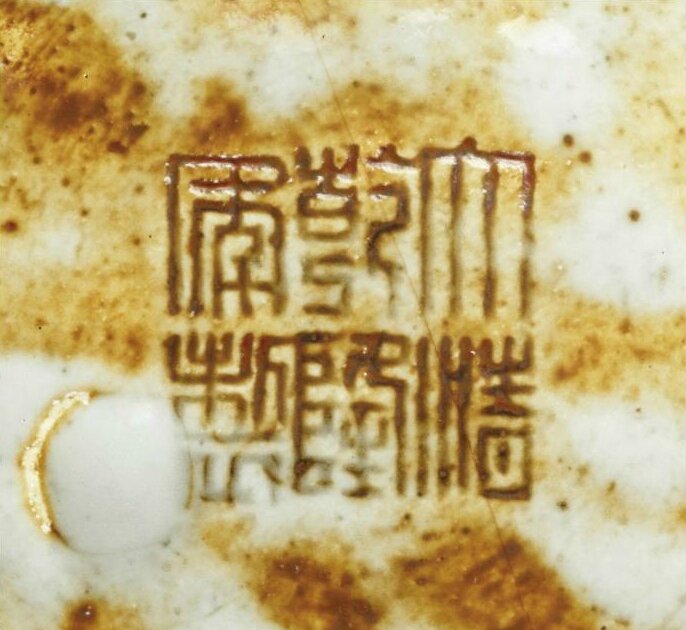A large flambé-glazed bottle vase, Qianlong six-character incised seal mark and of the period (1736-1795)
A large flambé-glazed bottle vase, Qianlong six-character incised seal mark and of the period (1736-1795). Estimate $60,000 – $80,000. Photo Christie's Image Ltd 2015
The heavily potted vase has an ovoid body that tapers to a cylindrical neck and is covered with a rich streaked glaze of dark crushed-strawberry red and milky blue draining to mushroom at the rim. The interior has a greyish-celadon glaze and the base a mottled celadon glaze. 18 in. (45.8 cm.) high
Provenance: Private collection, New York, acquired before 1940, and thence by descent to the present owner.
PROPERTY FROM THE COLLECTION OF GEORGE AND NETTIE FOWLKES, HOBE SOUND, FLORIDA
Notes: This distinctive glaze first appeared during the Yongzheng period and seeks to recreate the famous classical Jun wares of the Song dynasty. The splashes and streaks characteristic of this glaze are described as yao bian, or 'transmutation glaze', which has been the subject of much research. For a discussion of this topic see R. Kerr, Chinese Ceramics: Porcelain of the Qing Dynasty 1644-1911, London, 1986, p. 75, and N. Wood, 'The Evolution of the Chinese Copper Red', by R. Scott (ed.), Chinese Copper Red Wares, Percival David Foundation of Art, London, 1992, pp. 29-30.
The potters at the imperial Jingdezhen kilns were charged with the task of reproducing these glazes on porcelain. Such was the enthusiasm of the Yongzheng emperor for Jun glazes that the important Taocheng jishi bei (Commemorative Stele on Ceramic Production), composed by the famous imperial kiln director Tang Ying in 1735, lists no fewer than nine different Jun-type glazes, and noted that five of these were based upon ancient examples that had been sent from the palace in Beijing to the imperial kilns hundreds of miles to the south at Jingdezhen, in Jiangxi province. In order to achieve successful imitation of Jun glazes, Tang Ying went to considerable lengths, including sending his secretary Wu Yaopu to Junzhou in 1729 to try and obtain the recipe for Jun glazes. This dedication to the accurate recreation of Song dynasty glazes continued into the Qianlong period, and is evident on the present lot.
A flambé-glazed vase with Qianlong mark, of similar size to the present vase, was sold at Christie’s Hong Kong, 3 December 2008, lot 2571.
Christie's. FINE CHINESE CERAMICS AND WORKS OF ART, 17 - 18 September 2015, New York, Rockefeller Plaza

/https%3A%2F%2Fprofilepics.canalblog.com%2Fprofilepics%2F1%2F0%2F100183.jpg)
/https%3A%2F%2Fstorage.canalblog.com%2F03%2F02%2F119589%2F96711876_o.jpg)
/https%3A%2F%2Fstorage.canalblog.com%2F11%2F31%2F119589%2F94773502_o.jpg)
/https%3A%2F%2Fstorage.canalblog.com%2F20%2F83%2F119589%2F94772815_o.jpg)
/https%3A%2F%2Fstorage.canalblog.com%2F26%2F72%2F119589%2F75604929_o.jpg)
/https%3A%2F%2Fstorage.canalblog.com%2F59%2F60%2F119589%2F26458628_o.jpg)




/image%2F1371349%2F20240331%2Fob_a6f470_2024-nyr-22642-0857-000-a-large-black.jpg)
/image%2F1371349%2F20240329%2Fob_2f6b6c_854-1.jpg)
/image%2F1371349%2F20240329%2Fob_54ca74_114-1.jpg)
/http%3A%2F%2Fstorage.canalblog.com%2F77%2F04%2F119589%2F129856496_o.jpg)